Viñales, Cuba
We checked out of our hotel in Havana (see my previous post) and drove to Viñales, in the west of Cuba.
One of our stops along the way was Salto de Soroa (Soroa Waterfall), a popular picnic spot. There are lots of steps and some dubiously wobbly handrails on the hike to the top of the waterfall, where I took my photographs. I didn’t take the steps that led down to the base of the fall, where people go swimming. There’s a cafe and bar next to the entrance, where a few of our group got beer and plantain chips while the rest of us checked out the waterfall.


 The above two photographs were taken from this lookout.
The above two photographs were taken from this lookout. 
We had lunch at a restaurant with spectacular views of Viñales Valley, aptly named Restaurante Buena Vista. My hotel buffet breakfast seemed an eternity ago. I thoroughly enjoyed my lunch of fresh fruit (banana and papaya), plantain crisps and salad (shredded cabbage, tomato, cucumber and avocado), followed by chunky vegetable soup, and then main course of grilled fish with yuca, rice and beans, washed down with a tall glass of fresh pineapple juice.
 The restaurant overlooks Viñales Valley
The restaurant overlooks Viñales Valley  Vegetable soup
Vegetable soup Yuca, also known as cassava, tastes like a bland, very sticky potato – not everyone was a fan (I didn’t mind it).
Yuca, also known as cassava, tastes like a bland, very sticky potato – not everyone was a fan (I didn’t mind it). 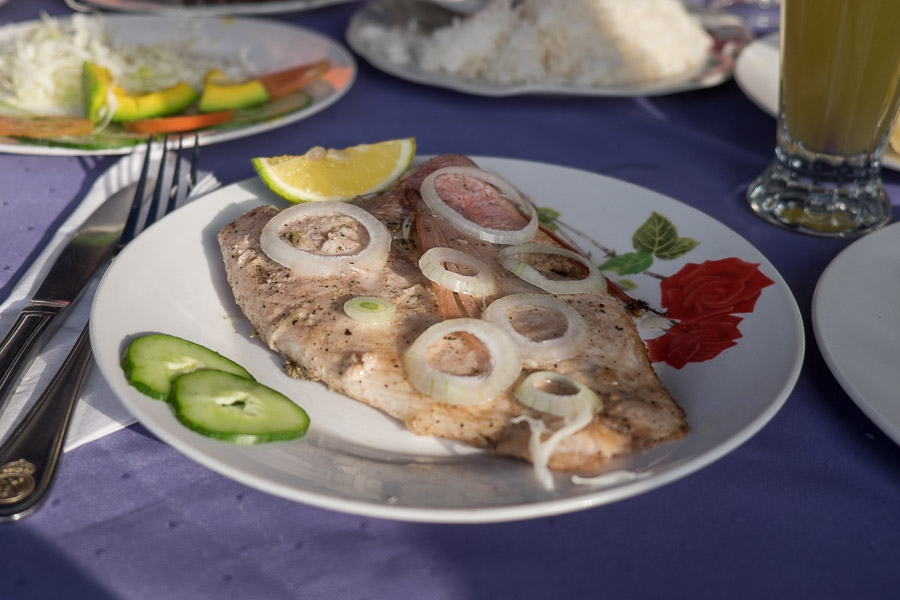 Fish simply grilled with salt, pepper and lemon.
Fish simply grilled with salt, pepper and lemon. We stayed for two nights in Viñales in casas particulares, accommodation in private homes. People often shorten ‘casa particular’ to simply ‘casa’. We stayed in homes where each guest’s room had its own private bathroom, but in cheaper casas, guests may share a bathroom with other guests (but not with the resident family running the casa). Breakfast and laundry services, if offered by the casa, are at additional cost. To run a legal casa particular, a home owner must hold a hosting license and pay additional taxes each month to the Government. As each guest checks in, the owner will ask for their passport so that their details can be recorded and provided to Cuban Immigration. Most casa hosts will be happy to make recommendations on local activities and help organise tours and taxis if needed. While most towns will have hotels, a stay at a casa particular is considered an essential part of a Cuban holiday experience.
We split up into smaller groups, each group assigned to one of three casas in the same street.
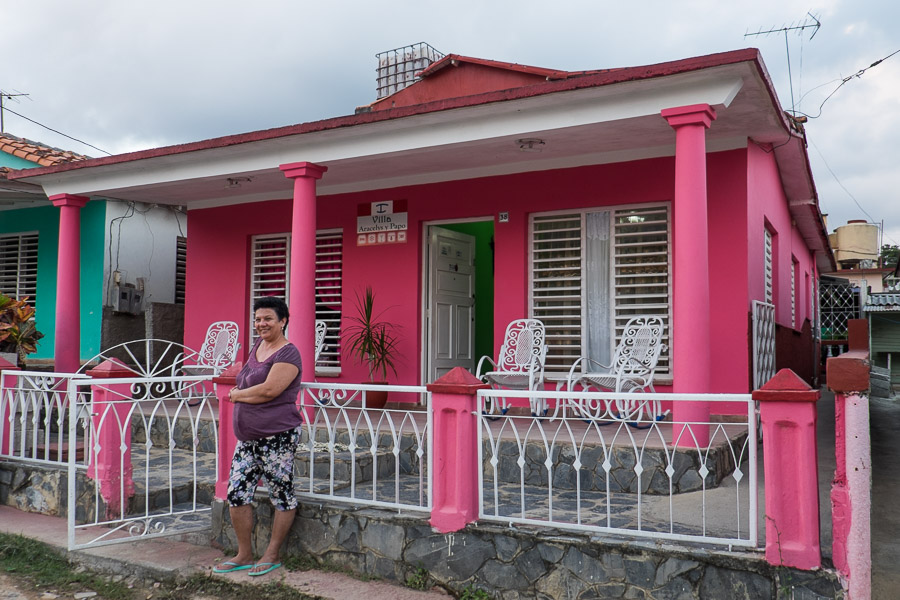 I stayed in this pink casa – Villa Aracelys y Papo. Aracelys was a terrific host, and although she didn’t speak a lot of English, understood it very well. The woman in this photo is not Aracelys – she’s one of the neighbours and part of the welcoming committee.
I stayed in this pink casa – Villa Aracelys y Papo. Aracelys was a terrific host, and although she didn’t speak a lot of English, understood it very well. The woman in this photo is not Aracelys – she’s one of the neighbours and part of the welcoming committee.  Casas particulares in Viñales display signs like this, with a blue symbol indicating the casa has a license to host tourists, and the name of the casa. The icons along the bottom indicate that this casa offers accommodation, air conditioning, bar, hot water and meals.
Casas particulares in Viñales display signs like this, with a blue symbol indicating the casa has a license to host tourists, and the name of the casa. The icons along the bottom indicate that this casa offers accommodation, air conditioning, bar, hot water and meals.  Little boys playing in our street when we arrived. Our tour bus was too large to go all the way down the street, so we schlepped our bags to the casas. Having traveled on my own a fair bit, I’m used to hauling my own suitcase, and so this was no problem for me – though it was a hot and sweaty five minutes, and with every bump and scrape, I dreaded to think how many years of life were taken off my suitcase’s wheels.
Little boys playing in our street when we arrived. Our tour bus was too large to go all the way down the street, so we schlepped our bags to the casas. Having traveled on my own a fair bit, I’m used to hauling my own suitcase, and so this was no problem for me – though it was a hot and sweaty five minutes, and with every bump and scrape, I dreaded to think how many years of life were taken off my suitcase’s wheels. My casa’s lounge
My casa’s loungeMy room was small and simple, but comfortable enough. I had a fan and air-conditioning unit, and a battery-operated bedside lamp, which turned out to be handy as the electricity cut out briefly, pre-sunrise on both mornings. The door you can see on the left led to my bathroom/toilet. Aracelys provided a couple of towels, soap (though I used my own) and toilet paper. I wish I had taken a picture to show you the electric shower, which our Cuban guides had assured us was quite safe. Despite the warning, it was somewhat counter-intuitive if not slightly alarming to see the wires coming out of the back of the shower head, connected through the wall, the first time I took a shower! The hot water was fine, though the warm days meant I didn’t really need super hot showers anyway. My room came with a key so I could keep it locked while I was out for the day. As we were out and about most of the day, my main interactions with Aracelys were at breakfast and dinner time.
 My room was lurid green!
My room was lurid green!  House bar menu displayed in Aracelys’ dining room. Drinks are at additional cost.
House bar menu displayed in Aracelys’ dining room. Drinks are at additional cost.We had breakfast at our casa each morning and each evening, we all met up at one of our casas for a potluck dinner, the dishes cooked by the owners of the three casas.
 Aracelys making lemon juice. She made fresh papaya juice for our breakfast every morning.
Aracelys making lemon juice. She made fresh papaya juice for our breakfast every morning.  Pineapples on the back steps
Pineapples on the back steps The dining room at breakfast time. In the thermoses are hot black coffee and hot milk.
The dining room at breakfast time. In the thermoses are hot black coffee and hot milk.  Breakfast included fresh fruit (papaya, pineapple, banana), cold meat, cheese, bread, and eggs, cooked by Aracelys to your liking. I had an omelette one morning, fried the next. Some of the group brought their own tea bags from home; I enjoyed the strong Cuban coffee with a little milk and sugar. If staying for more than a few days at a time I probably would go out to a cafe for breakfast, just for variety – apart from changing the way I had my eggs cooked, everything else would be the same for the casa breakfast each day.
Breakfast included fresh fruit (papaya, pineapple, banana), cold meat, cheese, bread, and eggs, cooked by Aracelys to your liking. I had an omelette one morning, fried the next. Some of the group brought their own tea bags from home; I enjoyed the strong Cuban coffee with a little milk and sugar. If staying for more than a few days at a time I probably would go out to a cafe for breakfast, just for variety – apart from changing the way I had my eggs cooked, everything else would be the same for the casa breakfast each day.  Our casa hosts cooked up a big feast for us both nights. Just before we all gathered for dinner, there was a flurry of activity as the other casa owners brought dishes to the designated casa.
Our casa hosts cooked up a big feast for us both nights. Just before we all gathered for dinner, there was a flurry of activity as the other casa owners brought dishes to the designated casa. 



Our second night’s dinner was very similar to the first – an assortment of meat and seafood, soup, vegetables and salad, and of course, rice and beans. Dessert on both nights included more fresh fruit and flan (like creme caramel).

 Both dinners in Viñales featured lobster, which of course I couldn’t eat, thanks to my crustacean allergy. The pork, chicken and fish dishes were delicious. And of course, I ate lots of rice and beans.
Both dinners in Viñales featured lobster, which of course I couldn’t eat, thanks to my crustacean allergy. The pork, chicken and fish dishes were delicious. And of course, I ate lots of rice and beans. The homes on our street were mostly casas particulares. We were just 5 minutes’ walk from the main street of Viñales town. The main street, where the majority of the town’s shops and restaurants are, was in much better condition than the side streets.



I lined up for well over an hour at the local telecommunications shop to buy a couple of wifi cards to get me two hours internet access ($5CUC per hour) which I used here in Viñales and in the next town, Trinidad. I could’ve walked away but by the time I thought about it, I’d been in line for so long it seemed silly to have waited for nothing – so I stayed. I had done my research, so I knew I must produce my passport to buy the wifi cards. When I finally made it into the shop, I couldn’t believe my bad luck – the guy in front of me walked out with his wifi cards and as I handed my passport over the counter, the system went down and no new orders could be processed. Having waited for so long to get to the front of the line, I waited even longer for the system to get back up again! The guys behind the counter were most apologetic; they shrugged, gave me wry smiles and said: “Welcome to Cuba”. Only a couple of people are allowed into the shop at a time, so for most of the time queueing, I was outside in the heat; at least it was air-conditioned inside. Queues for internet cards are a common sight in Cuba; if you plan to get in line while the sun is still out, don’t forget to put on sunscreen and wear a hat.
 I took this photo of the shop later that same day at sunset, when it was much cooler for the people queueing patiently for wifi cards. There was a queue at the shop at all hours that it was open.
I took this photo of the shop later that same day at sunset, when it was much cooler for the people queueing patiently for wifi cards. There was a queue at the shop at all hours that it was open.  In the background, behind the blue car, is the church courtyard – the town’s only wifi hotspot – where people can be seen using the internet on their mobile devices. To avoid the busiest time when the internet was at its slowest, I woke up early each morning and came here to send emails that I’d pre-written and saved offline. I’d be back at the casa in time for breakfast.
In the background, behind the blue car, is the church courtyard – the town’s only wifi hotspot – where people can be seen using the internet on their mobile devices. To avoid the busiest time when the internet was at its slowest, I woke up early each morning and came here to send emails that I’d pre-written and saved offline. I’d be back at the casa in time for breakfast. These guys were across the road, sitting outside a bar, within reach of the wifi signal, though it dropped out more frequently there. The wifi was strongest within the church courtyard.
These guys were across the road, sitting outside a bar, within reach of the wifi signal, though it dropped out more frequently there. The wifi was strongest within the church courtyard. We had a photo session at a nearby family-run tobacco farm, where Papa, Mama and Son were our models. With weather-beaten, brown and crinkly complexions resembling the dried tobacco leaves they worked with, they posed for pictures, showed us how cigars are rolled, and Mama brewed us Cuban coffee (while smoking a cigar).
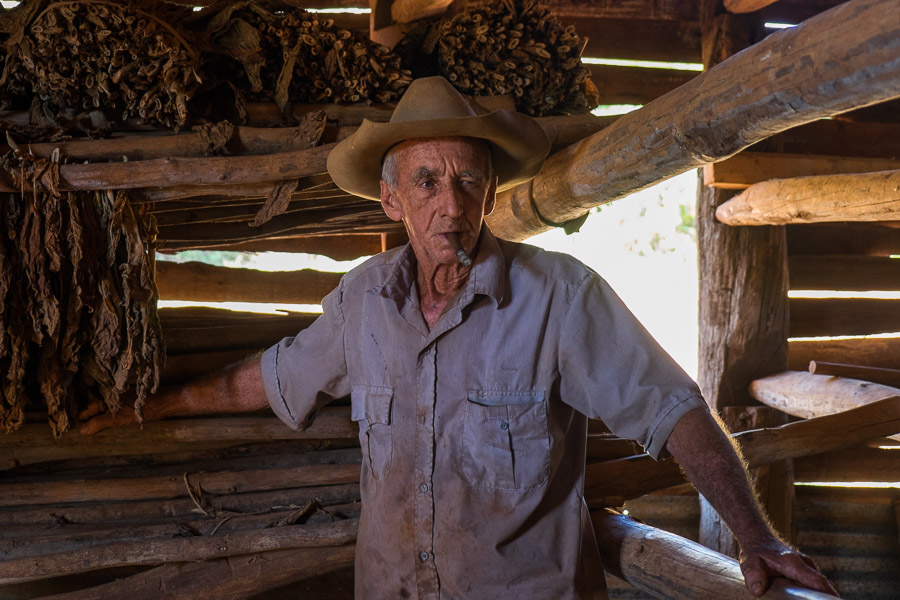
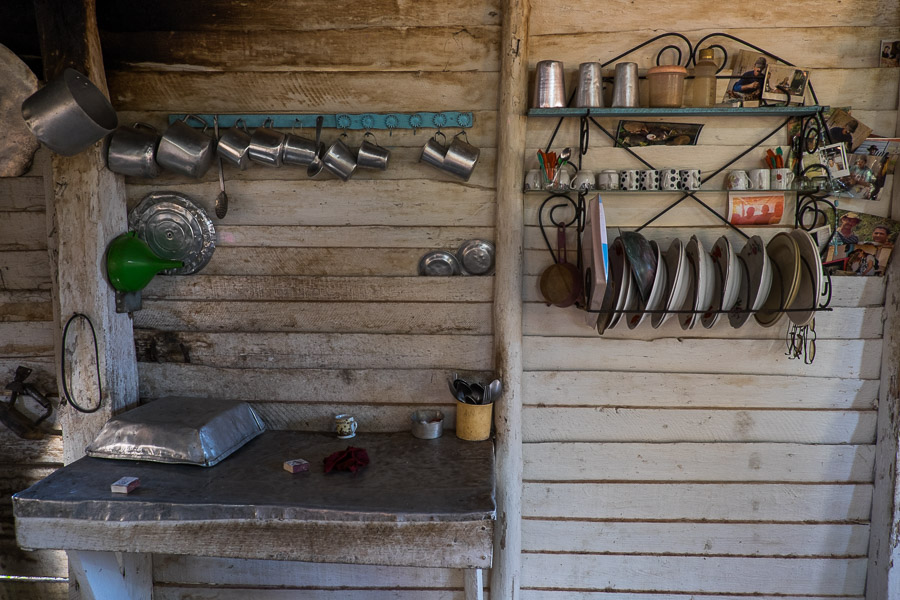




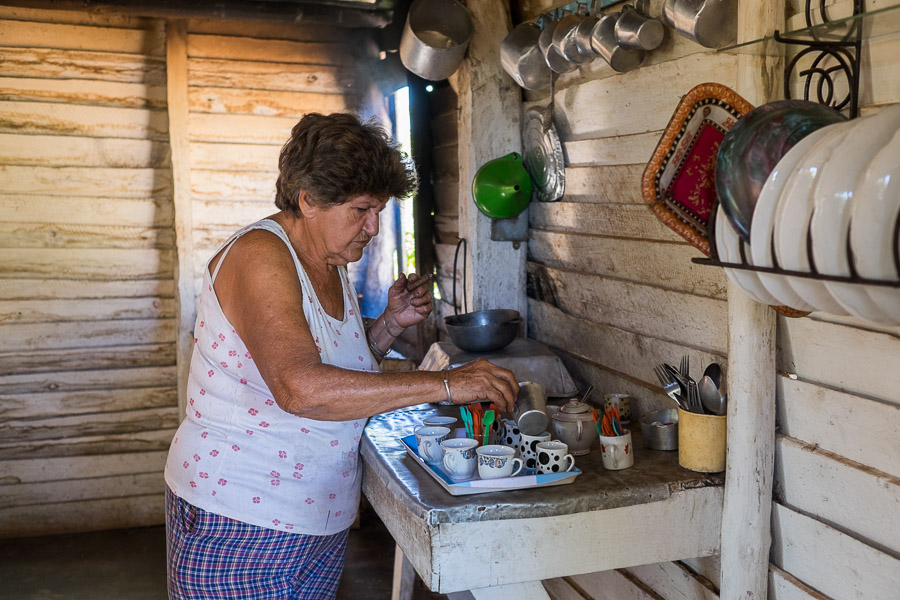



We had a wonderful meal at Finca Agroecologica El Paraiso, a family-run restaurant and organic farm. We started with their signature ‘anti-stress cocktail’, a cold and creamy concoction made with farm-grown herbs (mint, basil and anise), coconut milk and Cuban rum. And then the dishes kept coming from the kitchen, served family style: a hearty vegetable soup, a tangy pineapple and papaya salsa, impossibly smooth guacamole, plantain crisps, salads and roasted root vegetables, fried plantain fritters, rice and beans (of course!), pieces of roast chicken, stewed lamb, baked fish, and tender roast pork craved fresh off the spit. To finish, coffee and flan.

I’m sorry, I wasn’t able to photograph this meal properly. In these situations, sometimes it’s not possible to get into the right position to take pictures of all the food, depending on when dishes arrive and how they are spread out across a long table, where I happen to be positioned at the table, and whether I can get up and move around easily (in this case, I could not). Also, more importantly, I make it a point to not irritate the hell out of my fellow diners/travel companions by making them all wait while I photograph each dish – I didn’t want to be that person on the tour.
 It was an outstanding meal, one of my favourites of the entire trip. The pork crackling was AWESOME.
It was an outstanding meal, one of my favourites of the entire trip. The pork crackling was AWESOME.  The organic farm
The organic farm
I found Havana more interesting to photograph than Viñales; I just didn’t feel as excited about the pictures I took over my couple of days here. Having said that, I had a good experience, and really enjoyed the small country town feel, homestyle meals and hospitality. Given the opportunity, I’d be happy to visit Viñales again.
As our accommodation and meals were included in the photography tour cost, I couldn’t tell you exactly how much it cost for my two-night stay at Villa Aracelys y Papo. You can find information about room rates etc if you google ‘Villa Aracelys y Papo’. There are plenty of resources online with information and advice on casas particulares, what to expect and how to book.
 Casas particulares are a booming business in Viñales. Everywhere I walked, I’d see the brightly coloured houses with the familiar casa sign up front.
Casas particulares are a booming business in Viñales. Everywhere I walked, I’d see the brightly coloured houses with the familiar casa sign up front. 
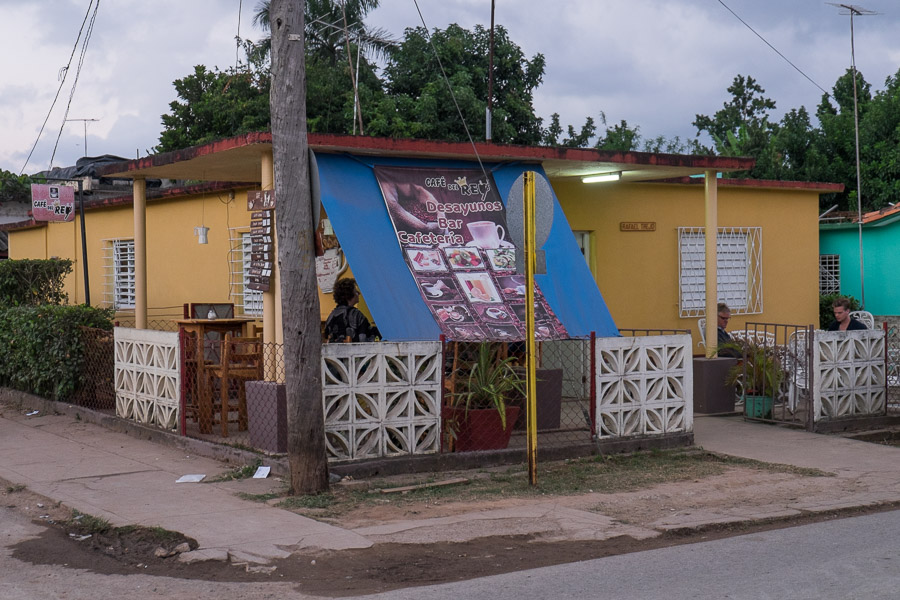 There were lots of cafes and restaurants in Viñales town, and lots of tourists to dine at them.
There were lots of cafes and restaurants in Viñales town, and lots of tourists to dine at them.  Every evening, there would be a long queue waiting to eat at the restaurant on the left, El Olivo.
Every evening, there would be a long queue waiting to eat at the restaurant on the left, El Olivo. 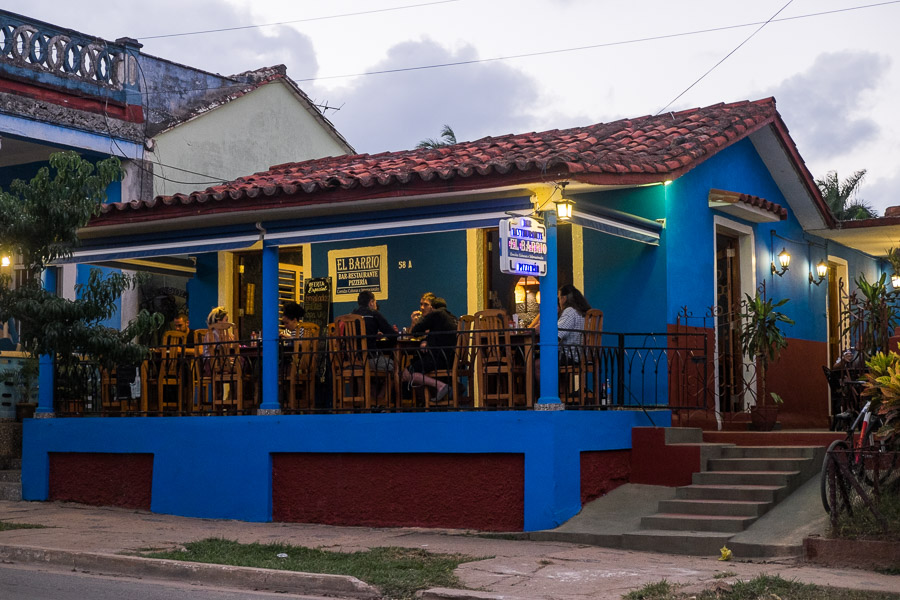



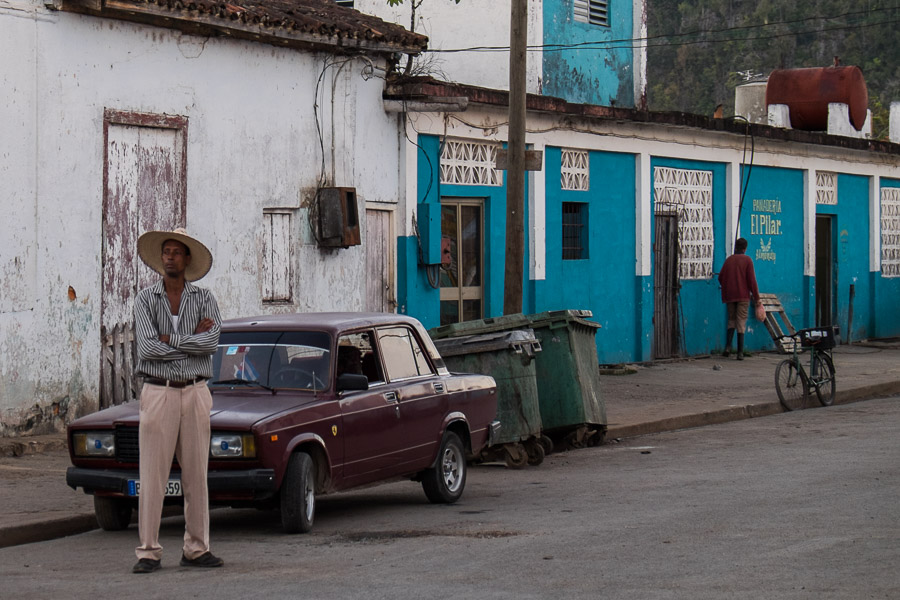

My Cuba series
I went to Cuba in November 2016, on a photography group tour.


